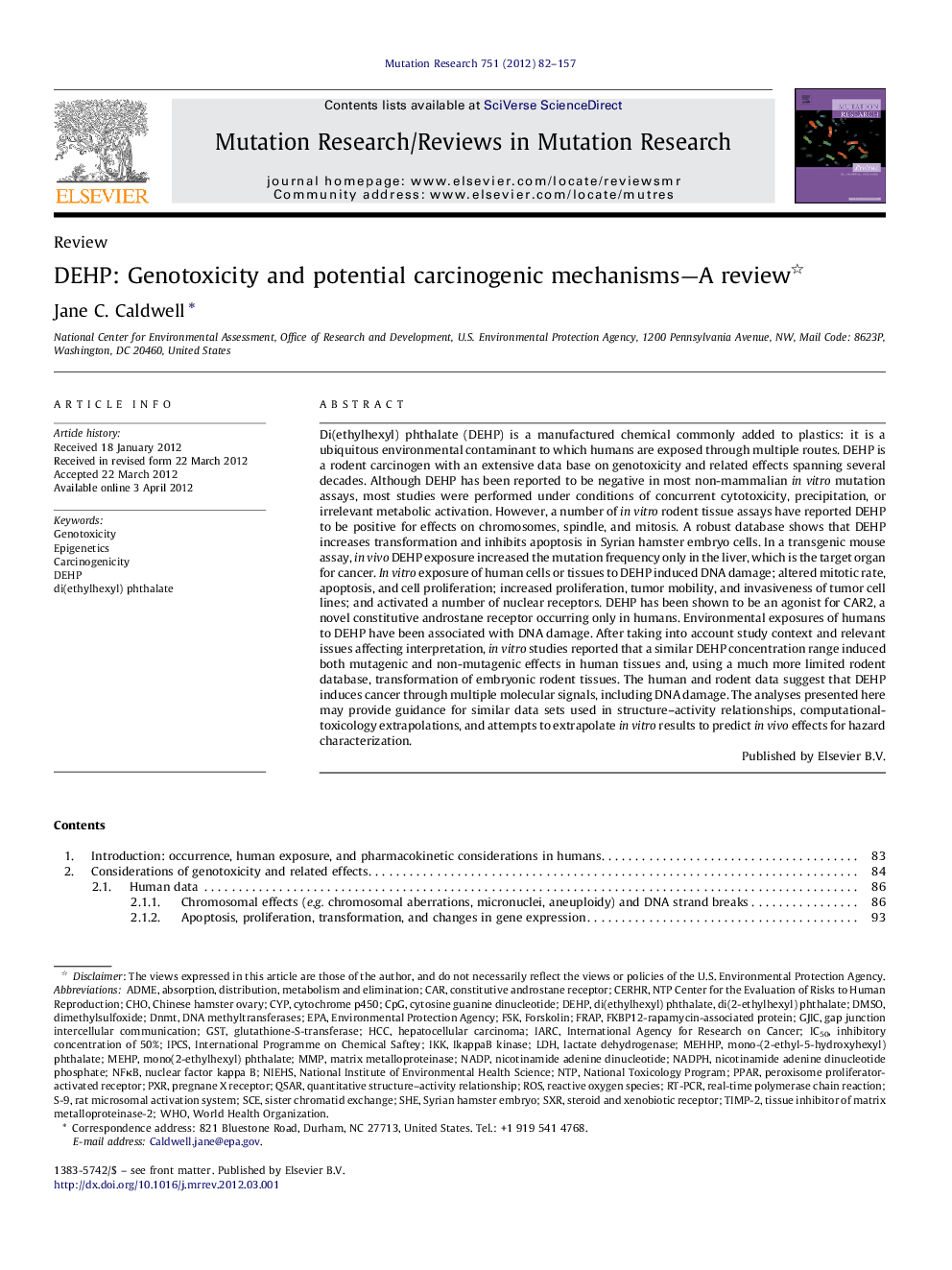| کد مقاله | کد نشریه | سال انتشار | مقاله انگلیسی | نسخه تمام متن |
|---|---|---|---|---|
| 10915287 | 1089880 | 2012 | 76 صفحه PDF | دانلود رایگان |
عنوان انگلیسی مقاله ISI
DEHP: Genotoxicity and potential carcinogenic mechanisms-A review
دانلود مقاله + سفارش ترجمه
دانلود مقاله ISI انگلیسی
رایگان برای ایرانیان
کلمات کلیدی
IPCsADMENADPHGSTFRAPRT-PCRFskPPARGJICCpGforskolinIKKDnmtDEHPIkappaB kinasePXRTIMP-2DNA methyltransferasesMEHPSteroid and xenobiotic receptorSXRNIEHSMEHHPCERHRS-9IARCIC50NADPEPASCECyPNTPMMPDMSO - DMSOHCC - HCCmono-(2-ethyl-5-hydroxyhexyl) phthalate - mono (2-ethyl-5-hydroxyhexyl) phthalatemono(2-ethylhexyl) phthalate - mono (2-ethylhexyl) phthalateNFκB - NFKBROS - ROSInternational Agency for Research on Cancer - آژانس بین المللی تحقیقات سرطانEnvironmental Protection Agency - آژانس حفاظت از محیط زیستGap junction intercellular communication - ارتباط بین سلولی Gap junctionSHE - اوEpigenetics - اپی ژنتیکCho - برایNational Toxicology Program - برنامه سم شناسی ملیQSAR - بزرگسال Sister chromatid exchange - تبادل کروماتید خواهرChinese Hamster Ovary - تخمدان هامستر چینیabsorption, distribution, metabolism and elimination - جذب، توزیع، متابولیسم و حذفSyrian hamster embryo - جنین هامستر سوریهDimethylsulfoxide - دیمتیل سولفواکسیدQuantitative structure–activity relationship - رابطه ساختاری و فعالیت کمیWorld Health Organization - سازمان بهداشت جهانیCarcinogenicity - سرطان زاییGenotoxicity - سمیت ژنتیکیCytochrome P450 - سیتوکروم پی۴۵۰Inhibitory concentration of 50% - غلظت مهاری 50٪nuclear factor kappa B - فاکتور هسته ای کاپا Blactate dehydrogenase - لاکتات دهیدروژناز LDH - لاکتات دهیدروژناز به صورت مختصر شده LDH matrix metalloproteinase - ماتریکس متالوپروتئینازCAR - ماشینnicotinamide adenine dinucleotide - نیکوتین آمید adenine dinucleotidenicotinamide adenine dinucleotide phosphate - نیکوتین آمید adenine dinucleotide phosphatereal-time polymerase chain reaction - واکنش زنجیره ای پلیمراز واقعی در زمان واقعیHepatocellular carcinoma - کارسینوم هپاتوسلولار(کارسینوم سلولهای استخوانی)WHO - کهglutathione-S-transferase - گلوتاتیون S-ترانسفرازReactive oxygen species - گونههای فعال اکسیژنconstitutive androstane receptor - گیرنده آندروستان پایدارperoxisome proliferator-activated receptor - گیرنده فعال فعال پروکسیومPregnane X receptor - گیرنده پیش گران X
موضوعات مرتبط
علوم زیستی و بیوفناوری
بیوشیمی، ژنتیک و زیست شناسی مولکولی
تحقیقات سرطان
پیش نمایش صفحه اول مقاله

چکیده انگلیسی
Di(ethylhexyl) phthalate (DEHP) is a manufactured chemical commonly added to plastics: it is a ubiquitous environmental contaminant to which humans are exposed through multiple routes. DEHP is a rodent carcinogen with an extensive data base on genotoxicity and related effects spanning several decades. Although DEHP has been reported to be negative in most non-mammalian in vitro mutation assays, most studies were performed under conditions of concurrent cytotoxicity, precipitation, or irrelevant metabolic activation. However, a number of in vitro rodent tissue assays have reported DEHP to be positive for effects on chromosomes, spindle, and mitosis. A robust database shows that DEHP increases transformation and inhibits apoptosis in Syrian hamster embryo cells. In a transgenic mouse assay, in vivo DEHP exposure increased the mutation frequency only in the liver, which is the target organ for cancer. In vitro exposure of human cells or tissues to DEHP induced DNA damage; altered mitotic rate, apoptosis, and cell proliferation; increased proliferation, tumor mobility, and invasiveness of tumor cell lines; and activated a number of nuclear receptors. DEHP has been shown to be an agonist for CAR2, a novel constitutive androstane receptor occurring only in humans. Environmental exposures of humans to DEHP have been associated with DNA damage. After taking into account study context and relevant issues affecting interpretation, in vitro studies reported that a similar DEHP concentration range induced both mutagenic and non-mutagenic effects in human tissues and, using a much more limited rodent database, transformation of embryonic rodent tissues. The human and rodent data suggest that DEHP induces cancer through multiple molecular signals, including DNA damage. The analyses presented here may provide guidance for similar data sets used in structure-activity relationships, computational-toxicology extrapolations, and attempts to extrapolate in vitro results to predict in vivo effects for hazard characterization.
ناشر
Database: Elsevier - ScienceDirect (ساینس دایرکت)
Journal: Mutation Research/Reviews in Mutation Research - Volume 751, Issue 2, OctoberâDecember 2012, Pages 82-157
Journal: Mutation Research/Reviews in Mutation Research - Volume 751, Issue 2, OctoberâDecember 2012, Pages 82-157
نویسندگان
Jane C. Caldwell,